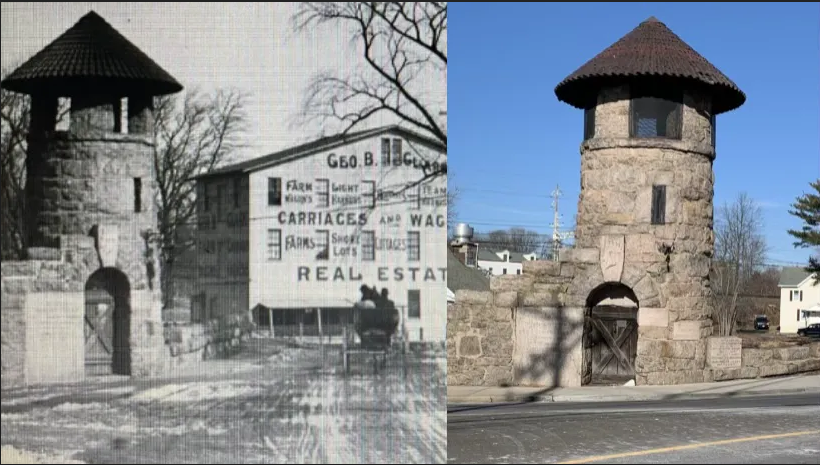The Unique History of Milford
Before and After: A Before and After Photo of the Robert Treat Memorial Bridge. Photo Courtesy: Pintrest.com and Cian Carroll, February 6, 2022.
Founded in 1639, Milford has exhibited traits of a coastal city with a beautiful downtown and several notable landmarks. The city we call home has changed dramatically over the past 383 years.
One of the oldest cities in all of the U.S. has a very rich history. From the U.S. becoming its own country, to Captain Kidd hiding his treasure on Charles Island, Milford has seen years of changes, though several staples have remained relevant. We recently met up with Arthur Stowe, a Milford Historian, to discuss some of these aspects of Milford.
Before and After:
Milford has clearly developed during its near four century history. Monuments such as Liberty Rock and the Robert Treat Memorial Tower have become some of the constants throughout our home’s history. Liberty Rock was a key lookout during the Revolutionary War, In Frank Juliano’s Milford: A Brief History book it writes, “One of the key lookouts was Hog Rock in what is now Devon; it was renamed Liberty Rock by Patriots.”
Milford also had the first Grinding Mill where the Milford Public Library is now located. Several buildings and landmarks have remained in our city and can still be seen today.
Oldest Houses:
Milford is also home to several vintage houses such as the Eells-Stow House (1700), Nathan Clark Stockade House (1659), and the Bryan-Downs House (1785). All of these three houses can be seen at the Milford Historical Society on 34 High Street.
The Eells-Stow house is believed to be the oldest house in Milford. The Eells-Stow house was home to Stephen Stow and his four sons, Stephen, Samuel, John, and Jedediah. The Nathan Clark Stockade House is known to be the first house built outside of Milfords stockade, which separated the settlers from the Native Americans. The Bryan-Downs House was built by Revolutionary War Captain Jehiel Bryan.
Yale Professor Charles F. Montgomery once stated, “Connecticut as a result must now be seen as one of the most architecturally interesting regions of the Colonial east coast, and it’s individual monuments”
Historical Figures:
Milford was home to three Connecticut Governors, Robert Treat, Jonathan Law, and Charles Hobbie Pond. Treat who was an early leader of Connecticut and, after his stint as Governor, went off and founded Newark, New Jersey. In the 1960s, Jonathan Law High School was built and named after Law, the 27 Governor of the Colony of Connecticut. Charles Hobbie Pond lived on the Milford Green, where The Cody White Funeral Home stands today.
The First Settlers made a treaty with the Native Americans called the “twig and turf ceremony.” Land known as the Wepawaug was gifted to the settlers. In 1639, Peter Prudden and followers from a New Haven Colony came to settle on this tract of land known now as Milford.
Peter Prudden was ordained the first pastor of the First Congregational Church of Milford. Stephen Stow was a member of the episcopal, now known as St. Peter’s Episcopal Church on 71 River Street and left because it favored the crown of England. Stow then went to the First Congregational Church which was a patriot church that favored independence.
Historical Events:
Milford’s most important events were between the Milford citizens and the British during the Revolutionary War. The Milford citizens never had disputes regarding the ownership of land with the Native Americans because the land was purchased from them.
Milford’s role in the American Revolution was very split: some favored the crown while others wanted their independence from England.
Milford’s Historian Arthur Stowe stated that one of the most important events involving the British happened on January 1, 1777, “it was a very cold rainy day when a British warship was spotted off the coast of Milford and that had scared the people. They tried to follow as it went on but then it disappeared. That evening, one of the local men heard a noise outside his house. He found 200 American soldiers in his backyard that had been captured by the British.”
The British had released the soldiers because they were infected with smallpox.
Stowe continues, “Milford citizens set up a pest house with the local doctor and a volunteer named Stephen Stow to help the 200 men that were left upon Milford’s shore with smallpox.”
Today, the Soldiers Monument lies in the Milford Cemetery, dedicated to Stow and the 200 victims of smallpox he cared for.
Another notable event involving the British and the Revolutionary War was when a lady altered the town to hide supplies from the British.
“The English were fighting a war 3,000 miles from home and it was a long journey to sail a ship over to bring supplies and food,” Stowe says. “The British would live off the land and find what they could.”
British ships off the coast of Point Beach were sending landing parties to gather cattle to feed their men. A local named Merwin alerted the Militia and then hid her cattle where Calf Pen Meadow is now.
It is hard to call one event out of Milford’s history the most important because of all the rich and exciting events Milford has witnessed throughout its history. But there is no doubt that many unique events have happened in this place we call home.
Your donation will support the student journalists of Foran High School. Your contribution will allow us to purchase equipment and cover our annual website hosting costs.

Hi, my name is Cian Carroll and I’m a senior at Foran High School. I am a staff writer for the Mane Street Mirror. I am a member of the Baseball team...

Hi, my name is Jimmy D’Angelo and I am a Senior at Foran High School. This is my third year writing for the Mane Street Mirror and I am the co-business...








Jane | Aug 20, 2024 at 7:40 PM
very interesting!